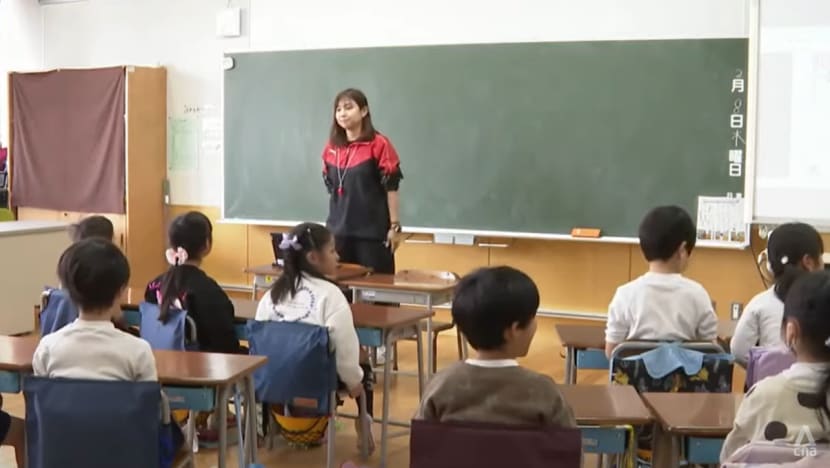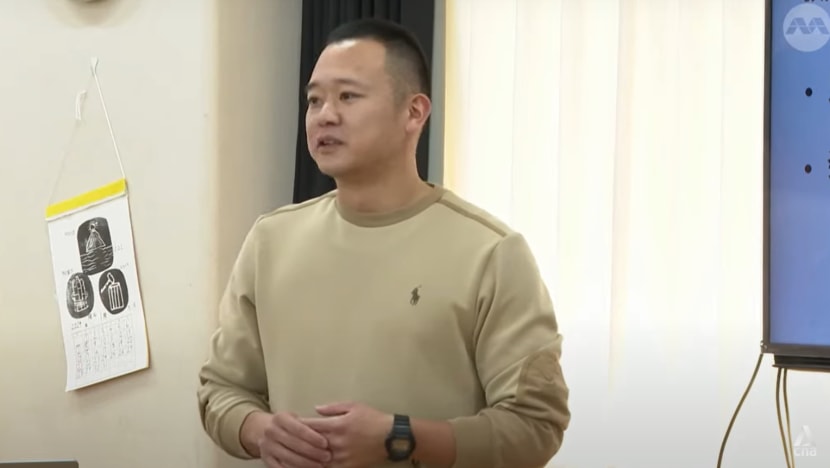‘Too many additional tasks’: Japan sees record high numbers of teachers quitting, taking mental health leave
CNA looks at how the country’s well-regarded education system has been impacted by a growing shortage of teachers, as record numbers take time off or even quit due to mental health reasons.

Shimoda Elementary School teacher Chiharu Kurayama teaching a class.

This audio is generated by an AI tool.
TOKYO: Ms Chiharu Kurayama teaches at Shimoda Elementary School in the Japanese capital’s Ota ward, where a typical day ends after 8pm – way past her official hours of 8am to 4.30pm.
The 41-year-old public school teacher handles almost every subject except for music, which is her only chance for a breather.
But work does not stop then. As a coordinator of special needs education, she needs to check on how students with special needs are coping.
During lunchtime, she sits with the children to watch out for signs of bullying or food allergies. When classes end around 2pm, she sorts out administrative matters and helps sixth-grade teachers make graduation certificates.
She also deals with calls from her students’ guardians, who can turn unpleasant. Complaints about problems like bullying reach her at least once a week.
She believes such tasks are not the job of a teacher.
“What is not about teaching classes would be better outsourced to someone else,” she told CNA.
“If we are given an environment where we can focus on providing education, the quality of classes could improve, and teachers will be smiling more often. But there are just too many additional tasks,” she added.
The lack of support came to a head when she had to add to her already heavy workload after several colleagues took leave over mental health issues. She herself had just returned from almost two months of treatment for hearing loss stemming from work-related stress.
“Their stories, and following up on the work they left behind, really stressed me out,” the 41-year-old Japanese public school teacher told CNA.

AT RISK OF KAROSHI
Ms Kurayama is not alone in the heavy workload she faces. Working overtime – or more than 14 hours a day – has become a norm among public school teachers.
Extracurricular activities like clubs and school trips called "tokkatsu" put an additional burden on them.
Although regulations state that teachers cannot be forced to do so, many feel pressured to work longer hours.
Latest education ministry figures show that 64.5 per cent of elementary school teachers exceed the cap for overtime, which is set at 45 hours a month.
For junior high school teachers, who must supervise club activities after school and on weekends, the figure stands at 77.1 per cent.
The situation comes amid record lows in the number of Japanese wanting to become teachers.
In a departure from the fierce competition for the job, a record low of 1.1 people applied for each vacancy in Tokyo's public elementary schools this year.
The city’s education board also said it is short of about 160 public elementary school teachers as of January, due to resignations and sick leave.
According to the latest figures from Japan’s education ministry, 12,192 public school teachers across the nation took leave due to mental illness in 2022, while another 953 resigned for the same reason in the 2021 academic year.
With fewer teachers, many who remain in the profession find themselves having to work even harder.
According to a survey conducted by the Japan Teachers’ Union last year, teachers in public schools put in an average of 96 hours of overtime a month.
This puts them at risk of "karoshi", or death from overwork. Japan regards over 80 hours of overtime as being in the karoshi danger zone.
“School teachers tend to think of work all the time,” said Ms Kurayama. “There is rarely any time when we do not have work on our minds and focus on our private lives.”
OFFICIALS CONSIDER REFORMS
Officials in Japan have acknowledged the need to tackle the issue urgently, by promoting reforms such as outsourcing and digitalising some tasks as well as increasing support staff.
Some schools, like Ms Kurayama’s, are taking the initiative to cut working hours too.
Shimoda Elementary School principal Kazuhiro Nakamura said they have stopped holding classes on Wednesday afternoons, while all classes now end after lunch.
“Teachers can focus on (other) duties in the afternoon. We encourage them to take a break and go home. That way, they can feel motivated to face the remaining days of the week,” he added.
Despite the school’s efforts, Ms Kurayama has found herself bogged down by meetings and unable to leave work earlier.
This has prompted Mr Nakamura to mull other changes, including playing to the teachers’ strengths, so that those who are good at counselling students, for instance, support those who are not.
He noted: “Everyone has strengths and weaknesses. If teachers can help one another, then each teacher can take on the role that suits them best, and the working environment will probably be better.”
SUPPORTING ONE ANOTHER
But such adjustments remain rare in Japan, primarily because public schools must first seek and receive approval from their local ward's education committee.
With changes slow to happen, some teachers are taking matters into their own hands to find a way to soldier on.
Mr Takashi Koshimizu, an educator of 18 years, started an education forum where schoolteachers gather to share their concerns and learn from one another.
Teachers from various schools take turns to host it on their day off, with some joining online.
They take turns giving lectures in an unconventional manner, such as by playing rock, paper and scissors. Many find its creative approach and sharing sessions more useful than the usual teacher training courses.
Ms Kurayama said: “Here, everyone breaks out of their shells. We become the children and we learn a lot.
“The way I speak to the children, the way I have a conversation, I learnt everything here.”
The teachers share similar issues among themselves, especially the burden of having to deal with a laundry list of tasks.
Mr Koshimizu called the current situation “abnormal”, stressing the importance of dividing roles among teachers and preventing people from hitting their limit.
"We are producers, we do the sales, planning, customer service, handle complaints, process them. These are handled by one person,” he added.
ROTATION TAKES A TOLL
Mr Koshimizu was transferred to another school last year, as Tokyo public school teachers are rotated to different schools every six years.
This can take a toll on morale and welfare, as in the case of his mentee, Ms Kumi Sugaya.
The 26-year-old was left floundering without anyone to guide her. Her mental health took a nosedive, but she could not take time off because she was the only homeroom teacher.
She ended up resigning in March after four years of being a public school teacher.

“To hold classes, I needed time to prepare for them but I did not have time during my working hours. I was doing it after five to six hours of classes, on Saturdays and Sundays, which cut down my personal time. The time spent on preparation wore me out,” she recounted.
Another former teacher, Mr Joji Miyazaki, joined the industry 10 years ago with aspirations to become a high school teacher.
Back then, only one in 20 who applied were accepted, so he chose to teach elementary school which was less competitive.
He told CNA that he then faced what the Japanese call “pawa hara”, or power harassment – a toxic side effect of a hierarchical work culture.
This, on top of the workload, caused him to fall into depression. The lack of reward, beyond seeing his students grow, finally pushed Mr Miyazaki to call it quits last year.
“I did not have a good relationship with my colleague (in school) … This person watched my classes, pointed out ‘this is bad, that is bad’ and ordered me to prepare better and show in advance what I had prepared,” he said.
“I did. Still, the response was that it was not good. Days went by and did not get any better. I felt exhausted.”
Mr Miyazaki spoke to management and his school principal, and even got medical counselling from the Tokyo Metropolitan Government – all to no avail.

LOW OVERTIME ALLOWANCE
Mr Miyazaki now works in another sector after a friend offered him an annual salary of 10 million yen (US$61,800).
This is almost double his previous salary of 6 million yen as a teacher, excluding overtime pay which is fixed at a flat 4 per cent of monthly salary under Japanese law, no matter how many hours are clocked. This rate has not been raised in more than 50 years.
Nearly 900,000 educators have signed petitions calling for the government to reduce their long hours of unpaid work.
Among the reforms that Japanese officials are considering is increasing wages like overtime allowances.
But for some, it is too little, too late. More than 12,000 quit before retirement age in the academic year ending 2022.
Across the nation, 64 per cent of public elementary school teachers said they are short-staffed, leading to cases where children have to self-study without supervision. Concerns are mounting that the quality of learning at schools is worsening.
ARE THINGS BETTER AT PRIVATE SCHOOLS?
Some teachers like Mr Yuya Koga have gone down the private route.
He teaches social studies at Kaetsu Ariake Junior and Senior High School in Koto word, which has both junior high and high school divisions.
Only about 1 per cent of elementary schools in Japan are privately run, though the figure goes up to 27 per cent at the high school level.
Private school teachers get more autonomy and do not need to stick to the textbooks, but the burden of overseeing all aspects of student welfare still falls on them.

Mr Koga leaves by 7.30pm, under school rules put in place to protect teachers' welfare. He then takes home unfinished work and ends up clocking 11 hours of work.
Still, he believes he is better off than public school teachers, who report to the local government.
Another key difference is access to resources.
Unlike public junior high schools, where tuition is free and teacher training is structured, private schools charge substantial tuition fees. At Kaetsu Ariake, school fees for the first year amount to almost 1.3 million yen (US$8,000).
In turn, they have a say in how they hire and support their teachers.
Mr Koga was offered a one-year sabbatical to study abroad at the school's expense, under a new programme launched this year. He is now reading philosophy at Hawaii University.
His absence left the school struggling to find a substitute, though a teacher returning from maternity leave was ultimately able to cover for him.
GOVERNMENT TO EASE LICENCE REQUIREMENTS
Kaetsu Ariake’s challenge of getting suitable replacements for Mr Koga is a symptom of the decline of the profession in Japan.
The education ministry is trying to encourage more young people to join the profession, such as by easing requirements to obtain teaching licences from the fiscal year 2025.
However, educators and experts said that what is really needed is reduction of workloads, like narrowing the scope of teachers’ duties and hiring more support staff.
This likely requires an increase in education funding, but the proportion of the country’s budget spent on education has fallen in recent years - from 8 per cent in 2001, to 4.9 per cent in 2022.
Some teenagers also told CNA that their teachers’ experiences are deterring them from becoming a teacher, even though it ranks among the top 10 desired jobs for high school students according to a January survey by popular social media app Line.
Even as teachers near their breaking point, attitudes about their responsibilities are hard to change as well.
“I am from the generation that works 24 hours,” said Kaetsu Ariake’s vice-principal Mitsuru Adachi.
“Today, we have to tell teachers to go home when the time comes, but deep inside, I ask why they cannot keep on going.
“I won’t dare to show (my feelings). I tell them it is part of their job to go home."


















